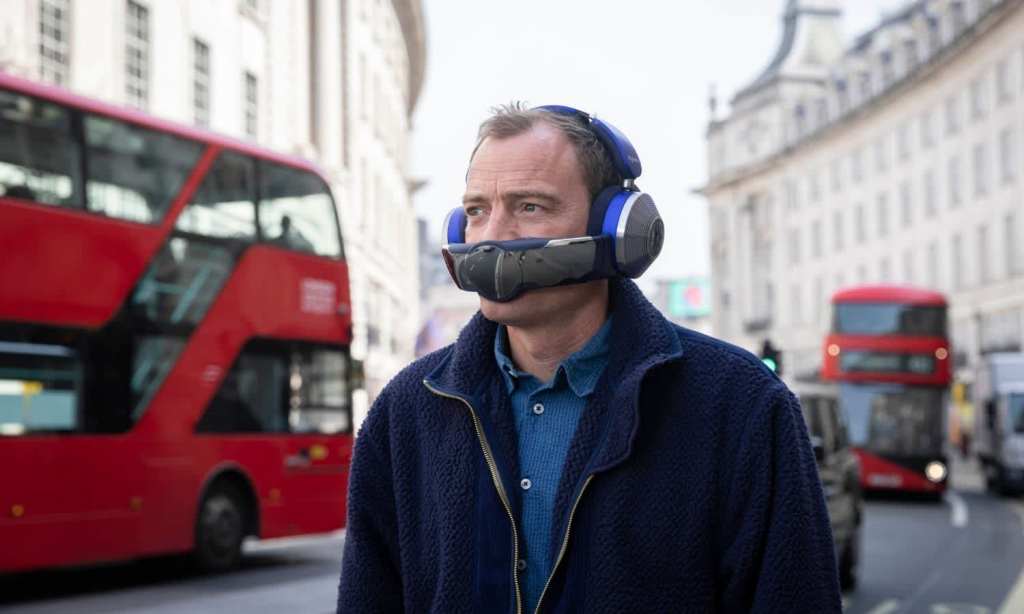Last year, Dyson announced its first foray into wearable, a pair of headphones called Dyson Zone. The result of over a decade of research and development, the headphones are aimed at tackling both noise pollution and poor air quality.
With the announcement released around April 2022, many thought the headphones, which come with an air-purifying attachment placed over your mouth were an April Fool’s Day gag. Turns out, it wasn’t — Dyson really is planning to make apocalypse chic happen.
In fact, the headphones have already been released in the US, with a price tag of USD $949. Though the launch date and pricing for Australia haven’t yet been announced, the US’s price converts to around AUD $1400.
View this post on Instagram
Reviewer Victoria Song wrote for The Verge that the air-purifying visor snaps into place via magnets, and can be easily pulled down when you need to interact with people. The headphones can also automatically switch to a conversation mode that pauses music so you can hear what’s happening around you.
“With noise cancelling on, it’s extremely hard to hear conversations going on around you, so this is definitely a necessary feature for anyone who’d wear something like this in public,” Song writes.
Related: Dyson’s Gen5 Detect Vacuum Is So Good It’ll Basically Clean Your Home for You
Related: Dyson’s New Air Purifying Headphones Are Making Apocalypse Chic Happen
She also notes that Dyson has said it anticipates most people will use the headphones on their own, using the visor only when it makes sense — like when walking past a construction site or in particularly polluted areas.
“Indeed, sans visor, the Zone looks simply like top-of-the-range headphones,” writes reviewer Benedict Brook for news.com.au. “Something else remarkable: the visor looks solid, but it’s incredibly flexible and almost crush-proof. You can bend it, fold it and — said Dyson — stomp on it and it’ll stay intact.”

Most all reviews of the device have noted that the headphones are significantly heavier than others on the market, including Airpods Max. “Put the Dyson Zone on and you barely feel the weight, such is the padding and the ergonomic design,” writes Brook. “Although you might not want to do vigorous exercise as it could have a habit of moving around.”
“Air pollution is a global problem — it affects us everywhere we go,” said Chief Engineer Jake Dyson when the headphones were announced. “In our homes, at school, at work and as we travel, whether on foot, on a bike or by public or private transport. The Dyson Zone purifies the air you breathe on the move. And unlike face masks, it delivers a plume of fresh air without touching your face.”
The headphones have sensors that detect how fast the wearer is moving and then automatically adjust the airflow between three intensity levels to ensure they’re delivering up to 5 litres of clean air a second — the equivalent breathing rate of a jog.
An air quality sensor also monitors pollution levels around you and sends the data to an app on your phone, telling you when to replace the filters, which should last for up to 12 months, depending on how polluted the environment is.

As for the Dyson Zone’s design, engineers took inspiration from the shape and design of a horse’s saddle. Like a saddle, which curves over the horse’s spine distributing the load, the headphones distribute weight over the sides of the head, rather than on the top.
The ear cushions are made with foam tested for the best density, rate of compression and spring-back rate — all of which provide ideal pressure to the head and delivery of acoustics. Moulding around the ear increases the size of the contact points providing better sealing — and inhibiting additional urban noise entering the ear.
As Brook put it best, “this time next year, we should know if the Zone was an aesthetic step too far or if, like Bluetooth pieces, it’s a bit of tech we’ll all get used to surprisingly swiftly.”
Read more stories from The Latch and subscribe to our email newsletter.







